
 |
 |
||||||||
|
|
Lessons Menu - Lesson 9 - Lesson 10 - Lesson 11 - Lesson 12 - Lesson 13- Lesson 14 - Lesson 15 - Lesson 16 |
| Lesson Plan 11 - Agriculture AGRICULTURE OVERVIEW |
download
lesson11.pdf |
|
|
OVERVIEW STUDENT OBJECTIVES CALIFORNIA HISTORY STANDARDS BACKGROUND ARTICLE 11 STUDENT ACTIVITY SHEET 11 AND KEY |
ADDITIONAL ITEMS AVAILABLE IN THIS LESSON PLAN: |
|
DOCUMENTS TO DISCUSS
(view online or print screen) |
||||
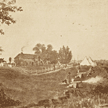 view large image |
1. Sutter's Hock
Farm [ca. 1849] This farm was one of the first agricultural projects in California. This photo of a painting shows the first steamboat that passed up the Feather River receiving a cannon salute from General Sutter at the Hock Farm. |
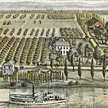 view large image |
2. Levi Painter's
fruit and vegetable ranch [1880] Shows the steamboat Julia on the Sacramento River in foreground; Painters Hall left; dock at right; farmhouse, barn, outbuildings, orchards, fields in the distance. The location is identified as one mile south of Courtland. |
|
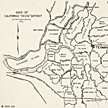 download PDF file |
3. Map of California Delta District [ca. 1920] Map of the Sacramento and San Joaquin River delta area northwest of Stockton; shows rail lines, rivers, sloughs, and Delta islands. |
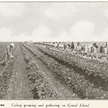 view large image |
4. Celery gathering
and growing on Grand Island [unknown] Workers on a celery farm in the Delta. |
|
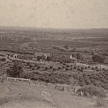 view large image |
5. Bella Vista Ranch near Rocklin [ca. 1890] View from the north of Bella Vista Ranch originally owned by the Thomas Marshbrowne family; shows house and outbuildings surrounded by orchards. |
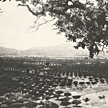 view large image |
6. Yolo County orchards [ca. 1910] Aerial view of orchards spreading across the valley floor. At lower right, people posed near fruit drying trays on the ground; at upper right foreground, foothills in the distance. |
|
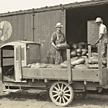 view large image |
7. Loading watermelons [ca. 1915] View of two men loading watermelons from a truck onto a railroad box car, at Orland. |
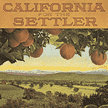 download PDF file |
8. California
for the Settler [1910] Southern Pacific Railroad booklet describes agricultural opportunities available in California. Includes the types of crops grown in each region of the state, with details about production and yields. |
|
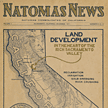 download PDF file |
9. Natomas News [1911] This newsletter includes photos of reclamation phases and equipment, including the Hercules, described as the largest clam shell dredge in the world. |
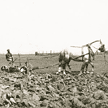 view large image |
10. Cultivating field,
Bear River area [1912] Land being cultivated with a horse-drawn disking machine. The field location is in the upper Bear River area Natomas Company Reclamation Dist. 1001. |
|
|
INSTRUCTIONS 2. Read Background Article 11. You may wish to read it to your students or print it and have them read it by themselves. Discuss any questions that they may have. 3. Show and discuss Document 1, Sutter's Hock Farm. Tell students that the image shows one of the first farm projects in California and ask them what time period it depicts. (1840s) What clues are in the image? (steamboat, cannons, clothing) What do they already know about John Sutter? Why would he need a farm? (to provide food for the settlers at Sutter's Fort) Ask why they think the men are shooting cannons? (The image shows a steamboat salute, but students may have other ideas before you tell them the occasion.) Why do they think that the Indians who lived in what is Northern California did not rely on farming for their food? What did they eat instead, and how did they obtain it? 4. Document 2, Levi Painter's fruit and vegetable ranch. This print shows a later view of a farm along the Sacramento River. What details can students identify in the image? The location is identified as one mile south of Courtland. How do they think a modern image of the same area might look today? What would have changed? 5. Document 3, Map of California Delta District and Document 4, Celery gathering and growing on Grand Island. What do students notice about the geography of the area depicted on the map? Do they recognize any of the names on the map? What do they think would be some of the challenges of living, traveling, and farming in this area? 6. Document 5, the Bella Vista Ranch near Rocklin and Document 6, Yolo County orchards. Have students determine how long ago the photos were taken. (1890 and 1910) Locate Rocklin and Yolo County on a map. How do they think the land in these areas would look today? For example, much of the area around Rocklin is now being filled with residential and commercial buildings. Discuss how population growth and development has affected farming in California. Is farming an important business in your area? How do people decide how land should be used in your community? 7. Document 7, Loading watermelons. Discuss the railroad’s impact on California agriculture. 8. Document 8, California for the Settlers. This 1910 booklet from the Southern Pacific Railroad celebrates the wonders of Northern California as a farming region. At this time, railroads and others who were interested in selling land for development and promoting tourism often published such brochures. Some of these publications made exaggerated claims about the climate and crops that could be successfully grown in California. Read the brochure to your students and have them decide how accurately it describes growing conditions at that time. Do students agree that there is no climactic difference between Northern and Southern California? Have them locate annual weather data to support their conclusions. Which crops shown are still widely grown commercially in Northern California? 9. Document 9, Natomas News and Document 10, Cultivating field, Bear River area. These images show some of the work involved in reclamation of the Delta lands for farming. Locate the Bear River area on a map. 10. Give students Activity Sheet 11: Agriculture Overview (printed from the PDF file). After they have finished the activity, discuss their answers as a group. FOLLOW-UP 2. Learn about the agricultural history of your own community. Find other websites to help you learn more. Where else can you find information? 3. Find out if any reclamation or irrigation projects were implemented in your own area. When were they started? What impact did they have on your community? 4. Look for more information on early farmers such as Levi Painter. You can find one article (originally published in 1890) on the internet at rootsweb.com REFERENCES AND RESOURCES 2003 Teacher resource guide: A guide to educational materials about agriculture. Chang, S. The bitter sweet soil: The Chinese in
California agriculture, 1860-1910 Kelley, R. L. Gold vs. grain: The hydraulic mining
controversy Kelley, R. L. Battling the inland sea: American
political culture, public policy, Jelinek, L.J. Harvest empire: A history of California
agriculture. McClurg, S. Water and the shaping of California Miller, C. and Hyslop, R. California: The geography of diversity. Schlebecker, J.T. Whereby we thrive: a history of American farming, 1607-1972 RELATED LINKS
California Department of Food and Agriculture Kids California Farm Bureau Federation California Foundation
for Agriculture in the Classroom
Early California History: An Overview
National Agriculture Statistics Service, Agriculture NASS Kids, Agriculture and Math Fun
Sacramento's Delta History |
| Sacramento History Online © 2003 - 2004 | |